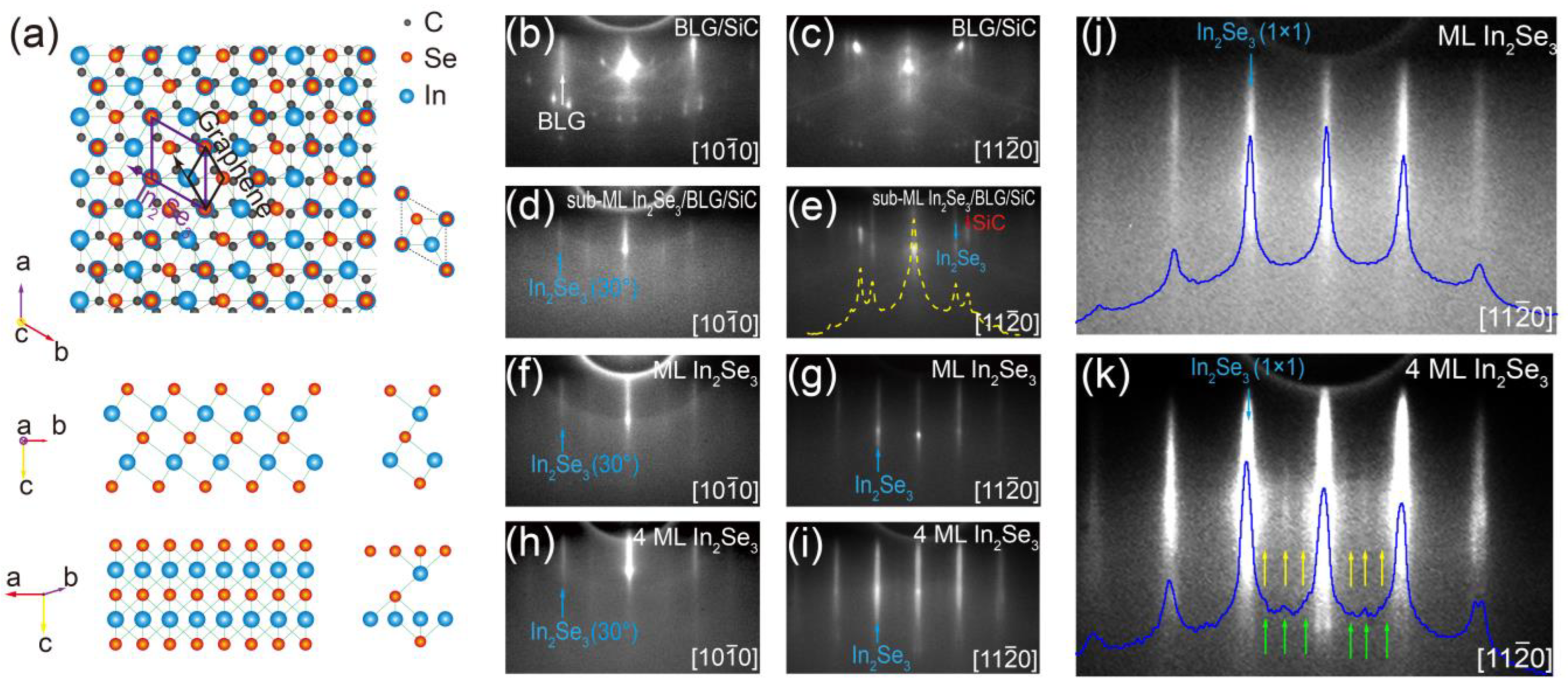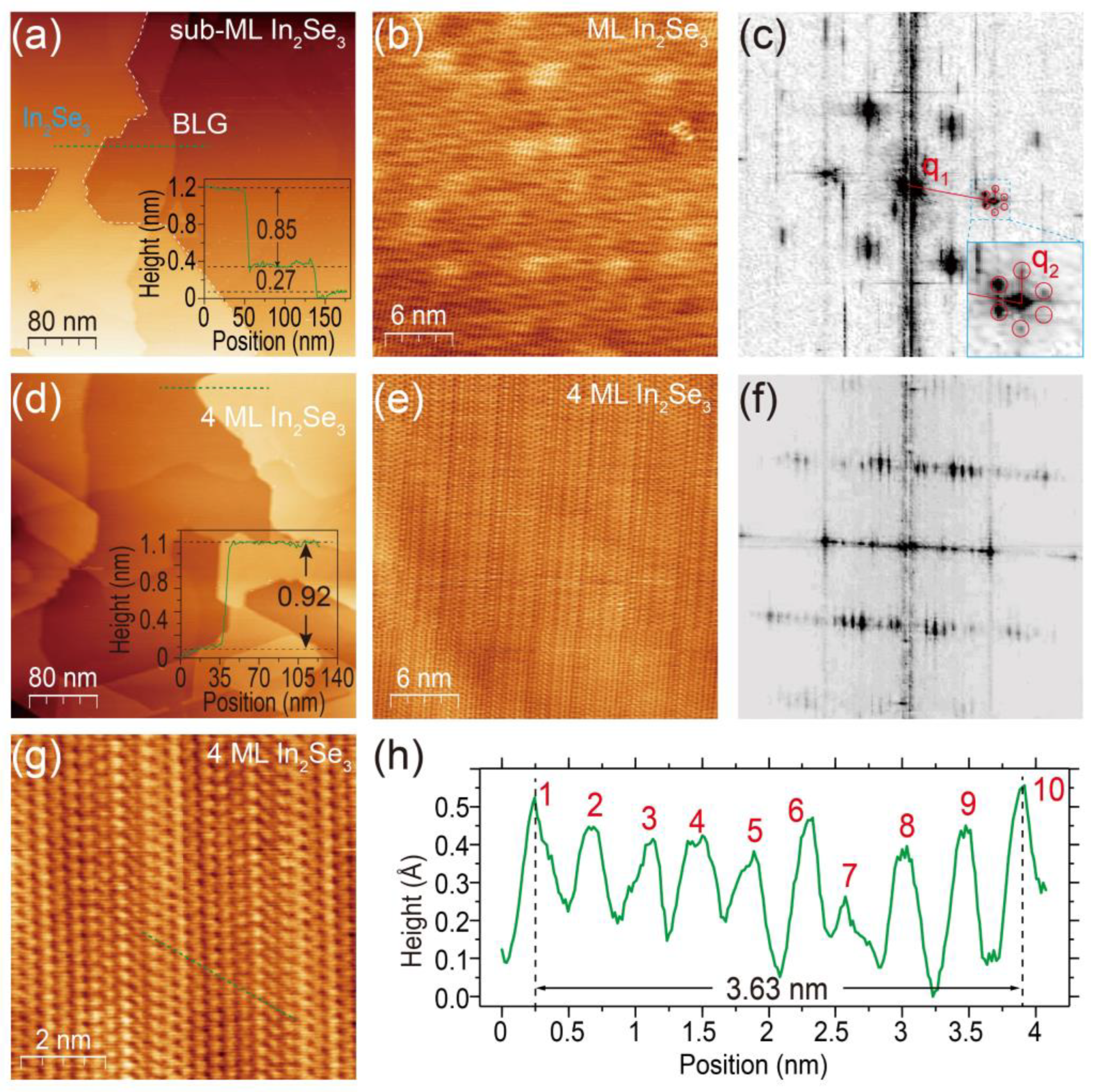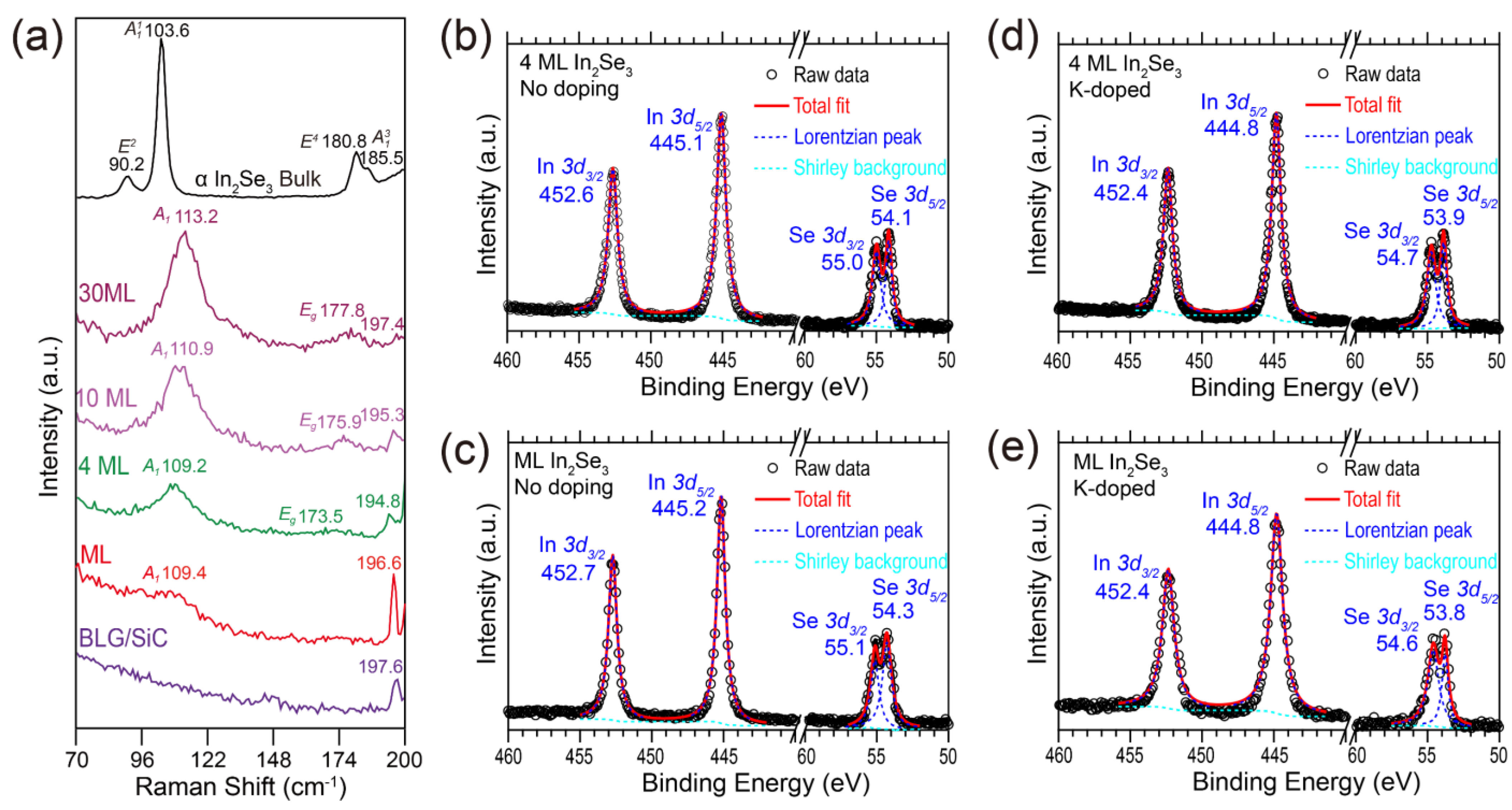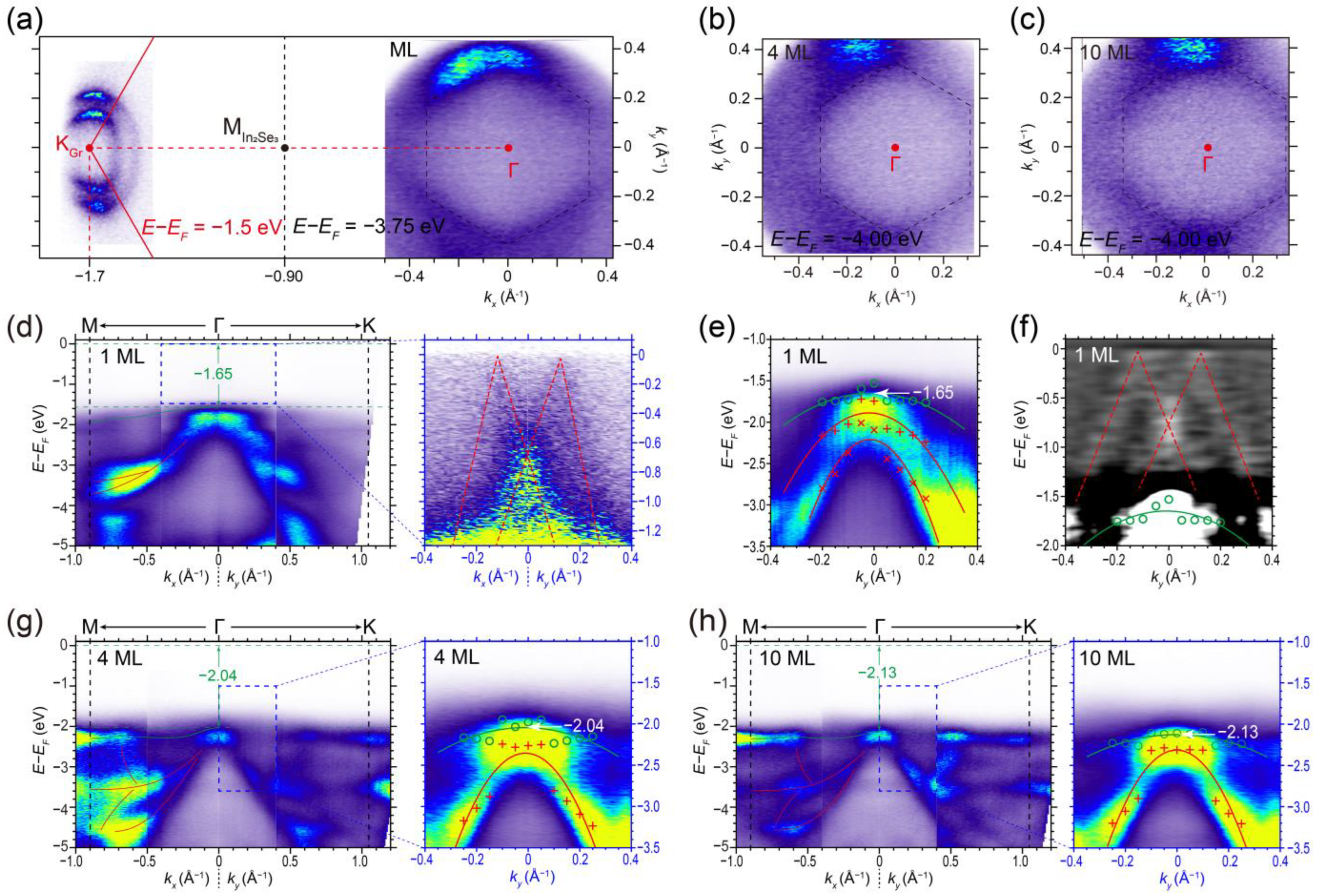Thickness-Dependent Evolutions of Surface Reconstruction and Band Structures in Epitaxial β–In2Se3 Thin Films
Abstract
1. Introduction
2. Methods
3. Results and Discussion
3.1. Surface Reconstructions of the Grown In2Se3 Films
3.2. Raman and XPS Characterizations of the Grown β–In2Se3 Films
3.3. Band Structures Evolution of β–In2Se3 Films
4. Conclusions
Supplementary Materials
Author Contributions
Funding
Data Availability Statement
Acknowledgments
Conflicts of Interest
References
- Scott, J.F. Applications of modern ferroelectrics. Science 2007, 315, 954–959. [Google Scholar] [CrossRef] [PubMed]
- Guo, R.; You, L.; Zhou, Y.; Lim, Z.S.; Zou, X.; Chen, L.; Ramesh, R.; Wang, J. Non-volatile memory based on the ferroelectric photovoltaic effect. Nat. Commun. 2013, 4, 1990. [Google Scholar] [CrossRef] [PubMed]
- Wen, Z.; Wu, D. Ferroelectric Tunnel Junctions: Modulations on the Potential Barrier. Adv. Mater. 2020, 32, 1904123. [Google Scholar] [CrossRef] [PubMed]
- Xu, Y. Ferroelectric Materials and Their Applications; Elsevier: Amsterdam, The Netherlands, 1991. [Google Scholar]
- Si, M.; Saha, A.K.; Gao, S.; Qiu, G.; Qin, J.; Duan, Y.; Jian, J.; Niu, C.; Wang, H.; Wu, W.; et al. A ferroelectric semiconductor field-effect transistor. Nat. Electron. 2019, 2, 580–586. [Google Scholar] [CrossRef]
- Bez, R.; Pirovano, A. Non-volatile memory technologies: Emerging concepts and new materials. Mater. Sci. Semicond. Process. 2004, 7, 349–355. [Google Scholar] [CrossRef]
- Mukherjee, S.; Koren, E. Indium Selenide (In2Se3)—An Emerging Van-der-Waals Material for Photodetection and Non-Volatile Memory Applications. Isr. J. Chem. 2022, 62, e202100112. [Google Scholar] [CrossRef]
- Huang, Y.T.; Chen, N.K.; Li, Z.Z.; Wang, X.P.; Sun, H.B.; Zhang, S.; Li, X.B. Two-dimensional In2Se3: A rising advanced material for ferroelectric data storage. InfoMat 2022, 4, e12341. [Google Scholar] [CrossRef]
- Cohen, R.E. Origin of Ferroelectricity in Perovskite Oxides. Nature 1992, 358, 136–138. [Google Scholar] [CrossRef]
- Nuraje, N.; Su, K. Perovskite ferroelectric nanomaterials. Nanoscale 2013, 5, 8752–8780. [Google Scholar] [CrossRef]
- Ding, W.; Zhu, J.; Wang, Z.; Gao, Y.; Xiao, D.; Gu, Y.; Zhang, Z.; Zhu, W. Prediction of intrinsic two-dimensional ferroelectrics in In2Se3 and other III2-VI3 van der Waals materials. Nat. Commun. 2017, 8, 14956. [Google Scholar] [CrossRef]
- Li, C.F.; Li, Y.Q.; Tang, Y.S.; Zheng, S.H.; Zhang, J.H.; Zhang, Y.; Lin, L.; Yan, Z.B.; Jiang, X.P.; Liu, J.M. Band structure, ferroelectric instability, and spin–orbital coupling effect of bilayer α–In2Se3. J. Appl. Phys. 2020, 128, 234106. [Google Scholar] [CrossRef]
- Novoselov, K.S.; Mishchenko, A.; Carvalho, A.; Castro Neto, A.H. 2D materials and van der Waals heterostructures. Science 2016, 353, aac9439. [Google Scholar] [CrossRef] [PubMed]
- Novoselov, K.S.; Geim, A.K.; Morozov, S.V.; Jiang, D.; Zhang, Y.; Dubonos, S.V.; Grigorieva, I.V.; Firsov, A.A. Electric field effect in atomically thin carbon films. Science 2004, 306, 666–669. [Google Scholar] [CrossRef] [PubMed]
- Toksumakov, A.N.; Ermolaev, G.A.; Slavich, A.S.; Doroshina, N.V.; Sukhanova, E.V.; Yakubovsky, D.I.; Syuy, A.V.; Novikov, S.M.; Romanov, R.I.; Markeev, A.M.; et al. High-refractive index and mechanically cleavable non-van der Waals InGaS3. NPJ 2D Mater. Appl. 2022, 6, 85. [Google Scholar] [CrossRef]
- Chen, W.; Hu, M.; Zong, J.; Xie, X.; Meng, Q.; Yu, F.; Wang, L.; Ren, W.; Chen, A.; Liu, G.; et al. Epitaxial Growth of Single-Phase 1T’-WSe2 Monolayer with Assistance of Enhanced Interface Interaction. Adv. Mater. 2021, 33, 2004930. [Google Scholar] [CrossRef]
- Zong, J.; Wang, Z.; Wang, K.; Meng, Q.; Tian, Q.; Qiu, X.; Xie, X.; Zhang, Y.; Jin, S.; Wang, C.; et al. Band structures of molecular beam epitaxially grown MoSe2–WSe2 heterobilayers with different stacking orders on SrTiO3(111) substrate. Appl. Phys. Lett. 2022, 121, 113103. [Google Scholar] [CrossRef]
- Cao, Y.; Fatemi, V.; Fang, S.; Watanabe, K.; Taniguchi, T.; Kaxiras, E.; Jarillo-Herrero, P. Unconventional superconductivity in magic-angle graphene superlattices. Nature 2018, 556, 43–50. [Google Scholar] [CrossRef]
- Qian, X.F.; Liu, J.W.; Fu, L.; Li, J. Quantum spin Hall effect in two-dimensional transition metal dichalcogenides. Science 2014, 346, 1344–1347. [Google Scholar] [CrossRef]
- Hasan, M.Z.; Kane, C.L. Colloquium: Topological insulators. Rev. Mod. Phys. 2010, 82, 3045–3067. [Google Scholar] [CrossRef]
- Guillamon, I.; Suderow, H.; Vieira, S.; Cario, L.; Diener, P.; Rodiere, P. Superconducting Density of States and Vortex Cores of 2H-NbS2. Phys. Rev. Lett. 2008, 101, 166407. [Google Scholar] [CrossRef]
- Kusmartseva, A.F.; Sipos, B.; Berger, H.; Forro, L.; Tutis, E. Pressure Induced Superconductivity in Pristine 1T-TiSe2. Phys. Rev. Lett. 2009, 103, 236401. [Google Scholar] [CrossRef] [PubMed]
- Bolshakov, A.D.; Fedorov, V.V.; Koval, O.Y.; Sapunov, G.A.; Sobolev, M.S.; Pirogov, E.V.; Kirilenko, D.A.; Mozharov, A.M.; Mukhin, I.S. Effective Suppression of Antiphase Domains in GaP(N)/GaP Heterostructures on Si(001). Cryst. Growth Des. 2019, 19, 4510–4520. [Google Scholar] [CrossRef]
- Mitin, D.M.; Bolshakov, A.D.; Neplokh, V.; Mozharov, A.M.; Raudik, S.A.; Fedorov, V.V.; Shugurov, K.Y.; Mikhailovskii, V.Y.; Rajanna, P.M.; Fedorov, F.S.; et al. Novel design strategy for GaAs-based solar cell by application of single-walled carbon nanotubes topmost layer. Energy Sci. Eng. 2020, 8, 2938–2945. [Google Scholar] [CrossRef]
- Koval, O.Y.; Fedorov, V.V.; Bolshakov, A.D.; Fedina, S.V.; Kochetkov, F.M.; Neplokh, V.; Sapunov, G.A.; Dvoretckaia, L.N.; Kirilenko, D.A.; Shtrom, I.V.; et al. Structural and Optical Properties of Self-Catalyzed Axially Heterostructured GaPN/GaP Nanowires Embedded into a Flexible Silicone Membrane. Nanomaterials 2020, 10, 2110. [Google Scholar] [CrossRef]
- Zhang, Y.; Chang, T.R.; Zhou, B.; Cui, Y.T.; Yan, H.; Liu, Z.; Schmitt, F.; Lee, J.; Moore, R.; Chen, Y.; et al. Direct observation of the transition from indirect to direct bandgap in atomically thin epitaxial MoSe2. Nat. Nanotechnol. 2014, 9, 111–115. [Google Scholar] [CrossRef]
- Zhang, Y.; Ugeda, M.M.; Jin, C.; Shi, S.F.; Bradley, A.J.; Martin-Recio, A.; Ryu, H.; Kim, J.; Tang, S.; Kim, Y.; et al. Electronic Structure, Surface Doping, and Optical Response in Epitaxial WSe2 Thin Films. Nano Lett. 2016, 16, 2485–2491. [Google Scholar] [CrossRef] [PubMed]
- Kibirev, I.A.; Matetskiy, A.V.; Zotov, A.V.; Saranin, A.A. Thickness-dependent transition of the valence band shape from parabolic to Mexican-hat-like in the MBE grown InSe ultrathin films. Appl. Phys. Lett. 2018, 112, 191602. [Google Scholar] [CrossRef]
- Hamer, M.J.; Zultak, J.; Tyurnina, A.V.; Zolyomi, V.; Terry, D.; Barinov, A.; Garner, A.; Donoghue, J.; Rooney, A.P.; Kandyba, V.; et al. Indirect to Direct Gap Crossover in Two-Dimensional InSe Revealed by Angle-Resolved Photoemission Spectroscopy. ACS Nano 2019, 13, 2136–2142. [Google Scholar] [CrossRef]
- Sang, D.K.; Wang, H.; Qiu, M.; Cao, R.; Guo, Z.; Zhao, J.; Li, Y.; Xiao, Q.; Fan, D.; Zhang, H. Two Dimensional beta-InSe with Layer-Dependent Properties: Band Alignment, Work Function and Optical Properties. Nanomaterials 2019, 9, 82. [Google Scholar] [CrossRef]
- Ho, C.-H.; Chen, Y.-C. Thickness-tunable band gap modulation in γ-In2Se3. RSC Adv. 2013, 3, 24896. [Google Scholar] [CrossRef]
- Li, W.; Sabino, F.P.; Crasto de Lima, F.; Wang, T.; Miwa, R.H.; Janotti, A. Large disparity between optical and fundamental band gaps in layered In2Se3. Phys. Rev. B 2018, 98, 165134. [Google Scholar] [CrossRef]
- Zheng, C.X.; Yu, L.; Zhu, L.; Collins, J.L.; Kim, D.; Lou, Y.D.; Xu, C.; Li, M.; Wei, Z.; Zhang, Y.P.; et al. Room temperature in-plane ferroelectricity in van der Waals In2Se3. Sci. Adv. 2018, 4, eaar7720. [Google Scholar] [CrossRef]
- Zhou, Y.; Wu, D.; Zhu, Y.; Cho, Y.; He, Q.; Yang, X.; Herrera, K.; Chu, Z.; Han, Y.; Downer, M.C.; et al. Out-of-Plane Piezoelectricity and Ferroelectricity in Layered alpha-In2Se3 Nanoflakes. Nano Lett. 2017, 17, 5508–5513. [Google Scholar] [CrossRef]
- Cui, C.; Hu, W.J.; Yan, X.; Addiego, C.; Gao, W.; Wang, Y.; Wang, Z.; Li, L.; Cheng, Y.; Li, P.; et al. Intercorrelated In-Plane and Out-of-Plane Ferroelectricity in Ultrathin Two-Dimensional Layered Semiconductor In2Se3. Nano Lett. 2018, 18, 1253–1258. [Google Scholar] [CrossRef] [PubMed]
- Wan, S.; Li, Y.; Li, W.; Mao, X.; Wang, C.; Chen, C.; Dong, J.; Nie, A.; Xiang, J.; Liu, Z.; et al. Nonvolatile Ferroelectric Memory Effect in Ultrathin α–In2Se3. Adv. Funct. Mater. 2019, 29, 1808606. [Google Scholar] [CrossRef]
- Wang, L.; Wang, X.; Zhang, Y.; Li, R.; Ma, T.; Leng, K.; Chen, Z.; Abdelwahab, I.; Loh, K.P. Exploring Ferroelectric Switching in α–In2Se3 for Neuromorphic Computing. Adv. Funct. Mater. 2020, 30, 2004609. [Google Scholar] [CrossRef]
- Mohapatra, P.K.; Ranganathan, K.; Dezanashvili, L.; Houben, L.; Ismach, A. Epitaxial growth of In2Se3 on monolayer transition metal dichalcogenide single crystals for high performance photodetectors. Appl. Mater. Today 2020, 20, 100734. [Google Scholar] [CrossRef]
- Claro Marcel, S.; Grzonka Justyna, N.N.; Ferreira Paulo, J.; Sadewasser, S. Wafer-Scale Fabrication of 2D β–In2Se3 Photodetectors. Adv. Opt. Mater. 2020, 9, 2001034. [Google Scholar] [CrossRef]
- Feng, W.; Gao, F.; Hu, Y.; Dai, M.; Li, H.; Wang, L.; Hu, P. High-performance and flexible photodetectors based on chemical vapor deposition grown two-dimensional In2Se3 nanosheets. Nanotechnology 2018, 29, 445205. [Google Scholar] [CrossRef] [PubMed]
- Li, J.; Li, H.; Niu, X.; Wang, Z. Low-Dimensional In2Se3 Compounds: From Material Preparations to Device Applications. ACS Nano 2021, 15, 18683–18707. [Google Scholar] [CrossRef]
- Almeida, G.; Dogan, S.; Bertoni, G.; Giannini, C.; Gaspari, R.; Perissinotto, S.; Krahne, R.; Ghosh, S.; Manna, L. Colloidal Monolayer beta-In2Se3 Nanosheets with High Photoresponsivity. J. Am. Chem. Soc. 2017, 139, 3005–3011. [Google Scholar] [CrossRef]
- Han, G.; Chen, Z.G.; Drennan, J.; Zou, J. Indium Selenides: Structural Characteristics, Synthesis and Their Thermoelectric Performances. Small 2014, 10, 2747–2765. [Google Scholar] [CrossRef] [PubMed]
- Kupers, M.; Konze, P.M.; Meledin, A.; Mayer, J.; Englert, U.; Wuttig, M.; Dronskowski, R. Controlled Crystal Growth of Indium Selenide, In2Se3, and the Crystal Structures of alpha-In2Se3. Inorg. Chem. 2018, 57, 11775–11781. [Google Scholar] [CrossRef]
- Balakrishnan, N.; Steer, E.D.; Smith, E.F.; Kudrynskyi, Z.R.; Kovalyuk, Z.D.; Eaves, L.; Patane, A.; Beton, P.H. Epitaxial growth of gamma-InSe and alpha, beta, and gamma-In2Se3 on epsilon-GaSe. 2D Mater. 2018, 5, 035026. [Google Scholar] [CrossRef]
- Lyu, F.; Li, X.; Tian, J.; Li, Z.; Liu, B.; Chen, Q. Temperature-Driven alpha-beta Phase Transformation and Enhanced Electronic Property of 2H alpha-In2Se3. ACS Appl. Mater. Interfaces 2022, 14, 23637–23644. [Google Scholar] [CrossRef] [PubMed]
- Okamoto, T.; Nakada, Y.; Aoki, T.; Takaba, Y.; Yamada, A.; Konagai, M. Structural control of In2Se3 polycrystalline thin films by molecular beam epitaxy. Phys. Status Solidi C 2006, 3, 2796–2799. [Google Scholar] [CrossRef]
- Lin, M.; Wu, D.; Zhou, Y.; Huang, W.; Jiang, W.; Zheng, W.; Zhao, S.; Jin, C.; Guo, Y.; Peng, H.; et al. Controlled growth of atomically thin In2Se3 flakes by van der Waals epitaxy. J. Am. Chem. Soc. 2013, 135, 13274–13277. [Google Scholar] [CrossRef]
- Rasmussen, A.M.; Teklemichael, S.T.; Mafi, E.; Gu, Y.; McCluskey, M.D. Pressure-induced phase transformation of In2Se3. Appl. Phys. Lett. 2013, 102, 062105. [Google Scholar] [CrossRef]
- Tao, X.; Gu, Y. Crystalline-crystalline phase transformation in two-dimensional In2Se3 thin layers. Nano Lett. 2013, 13, 3501–3505. [Google Scholar] [CrossRef] [PubMed]
- Ke, F.; Liu, C.; Gao, Y.; Zhang, J.; Tan, D.; Han, Y.; Ma, Y.; Shu, J.; Yang, W.; Chen, B.; et al. Interlayer-glide-driven isosymmetric phase transition in compressed In2Se3. Appl. Phys. Lett. 2014, 104, 212102. [Google Scholar] [CrossRef]
- Moreau, E.; Godey, S.; Ferrer, F.J.; Vignaud, D.; Wallart, X.; Avila, J.; Asensio, M.C.; Bournel, F.; Gallet, J.J. Graphene growth by molecular beam epitaxy on the carbon-face of SiC. Appl. Phys. Lett. 2010, 97, 241907. [Google Scholar] [CrossRef]
- Wang, Q.; Zhang, W.; Wang, L.; He, K.; Ma, X.; Xue, Q. Large-scale uniform bilayer graphene prepared by vacuum graphitization of 6H-SiC(0001) substrates. J. Phys. Condens. Matter 2013, 25, 095002. [Google Scholar] [CrossRef]
- Siegel, D.A.; Regan, W.; Fedorov, A.V.; Zettl, A.; Lanzara, A. Charge-Carrier Screening in Single-Layer Graphene. Phys. Rev. Lett. 2013, 110, 146802. [Google Scholar] [CrossRef]
- Li, X.; Zuo, X.; Li, H.; Han, L.; Gao, Q.; Li, D.; Cui, B.; Liu, D.; Qu, F. Exotic magnetism in As-doped alpha/beta-In2Se3 monolayers with tunable anisotropic carrier mobility. Phys. Chem. Chem. Phys. 2019, 21, 19234–19241. [Google Scholar] [CrossRef]
- Xu, C.; Mao, J.; Guo, X.; Yan, S.; Chen, Y.; Lo, T.W.; Chen, C.; Lei, D.; Luo, X.; Hao, J.; et al. Two-dimensional ferroelasticity in van der Waals beta’-In2Se3. Nat. Commun. 2021, 12, 3665. [Google Scholar] [CrossRef]
- Xu, C.; Chen, Y.; Cai, X.; Meingast, A.; Guo, X.; Wang, F.; Lin, Z.; Lo, T.W.; Maunders, C.; Lazar, S.; et al. Two-Dimensional Antiferroelectricity in Nanostripe-Ordered In2Se3. Phys. Rev. Lett. 2020, 125, 047601. [Google Scholar] [CrossRef]
- Zhang, F.; Wang, Z.; Dong, J.; Nie, A.; Xiang, J.; Zhu, W.; Liu, Z.; Tao, C. Atomic-Scale Observation of Reversible Thermally Driven Phase Transformation in 2D In2Se3. ACS Nano 2019, 13, 8004–8011. [Google Scholar] [CrossRef]
- Matetskiy, A.V.; Mararov, V.V.; Denisov, N.V.; Nguyen, D.L.; Hsing, C.R.; Wei, C.M.; Zotov, A.V.; Saranin, A.A. Characterization of the ferroelectric phase transition in monolayer In2Se3 grown on bilayer graphene. Appl. Surf. Sci. 2022, 600, 154032. [Google Scholar] [CrossRef]
- Wang, Z.; Hao, Z.; Yu, Y.; Wang, Y.; Kumar, S.; Xie, X.; Tong, M.; Deng, K.; Hao, Y.J.; Ma, X.M.; et al. Fermi Velocity Reduction of Dirac Fermions around the Brillouin Zone Center in In2Se3-Bilayer Graphene Heterostructures. Adv. Mater. 2021, 33, e2007503. [Google Scholar] [CrossRef] [PubMed]
- Koshino, M. Interlayer interaction in general incommensurate atomic layers. New J. Phys. 2015, 17, 015014. [Google Scholar] [CrossRef]
- Liu, L.; Dong, J.; Huang, J.; Nie, A.; Zhai, K.; Xiang, J.; Wang, B.; Wen, F.; Mu, C.; Zhao, Z.; et al. Atomically Resolving Polymorphs and Crystal Structures of In2Se3. Chem. Mater. 2019, 31, 10143–10149. [Google Scholar] [CrossRef]
- Nakashima, S.; Harima, H. Raman Investigation of SiC Polytypes. Phys. Status Solidi (A) 1997, 162, 39–64. [Google Scholar] [CrossRef]
- Shirley, D.A. High-Resolution X-Ray Photoemission Spectrum of the Valence Bands of Gold. Phys. Rev. B 1972, 5, 4709–4714. [Google Scholar] [CrossRef]
- Végh, J. The Shirley background revised. J. Electron Spectrosc. Relat. Phenom. 2006, 151, 159–164. [Google Scholar] [CrossRef]
- Moulder, J.F.; Stickle, W.F.; Sobol, P.E.; Bomben, K.D. Handbook of X-ray Photoelectron Spectroscopy; Chastain, J., Ed.; Perkin-Elmer Corporation, Physical Electronics Division: Eden Prairie, MN, USA, 1992. [Google Scholar]
- Weightman, P.; Roberts, E.D.; Johnson, C.E. L2,3MM Auger processes in selenium. J. Phys. C Solid State Phys. 1975, 8, 550. [Google Scholar] [CrossRef]
- Qi, Y.; Rhim, S.H.; Sun, G.F.; Weinert, M.; Li, L. Epitaxial Graphene on SiC(0001): More than Just Honeycombs. Phys. Rev. Lett. 2010, 105, 085502. [Google Scholar] [CrossRef]
- Benfatto, L.; Cappelluti, E. Spectroscopic signatures of massless gap opening in graphene. Phys. Rev. B 2008, 78, 115434. [Google Scholar] [CrossRef]
- Collins, J.L.; Wang, C.; Tadich, A.; Yin, Y.; Zheng, C.; Hellerstedt, J.; Grubišić-Čabo, A.; Tang, S.; Mo, S.-K.; Riley, J.; et al. Electronic Band Structure of In-Plane Ferroelectric van der Waals β′-In2Se3. ACS Appl. Electron. Mater. 2020, 2, 213–219. [Google Scholar] [CrossRef]
- Han, T.T.; Chen, L.; Cai, C.; Wang, Z.G.; Wang, Y.D.; Xin, Z.M.; Zhang, Y. Metal-Insulator Transition and Emergent Gapped Phase in the Surface-Doped 2D Semiconductor 2H-MoTe2. Phys. Rev. Lett. 2021, 126, 106602. [Google Scholar] [CrossRef] [PubMed]





Disclaimer/Publisher’s Note: The statements, opinions and data contained in all publications are solely those of the individual author(s) and contributor(s) and not of MDPI and/or the editor(s). MDPI and/or the editor(s) disclaim responsibility for any injury to people or property resulting from any ideas, methods, instructions or products referred to in the content. |
© 2023 by the authors. Licensee MDPI, Basel, Switzerland. This article is an open access article distributed under the terms and conditions of the Creative Commons Attribution (CC BY) license (https://creativecommons.org/licenses/by/4.0/).
Share and Cite
Meng, Q.; Yu, F.; Liu, G.; Zong, J.; Tian, Q.; Wang, K.; Qiu, X.; Wang, C.; Xi, X.; Zhang, Y. Thickness-Dependent Evolutions of Surface Reconstruction and Band Structures in Epitaxial β–In2Se3 Thin Films. Nanomaterials 2023, 13, 1533. https://doi.org/10.3390/nano13091533
Meng Q, Yu F, Liu G, Zong J, Tian Q, Wang K, Qiu X, Wang C, Xi X, Zhang Y. Thickness-Dependent Evolutions of Surface Reconstruction and Band Structures in Epitaxial β–In2Se3 Thin Films. Nanomaterials. 2023; 13(9):1533. https://doi.org/10.3390/nano13091533
Chicago/Turabian StyleMeng, Qinghao, Fan Yu, Gan Liu, Junyu Zong, Qichao Tian, Kaili Wang, Xiaodong Qiu, Can Wang, Xiaoxiang Xi, and Yi Zhang. 2023. "Thickness-Dependent Evolutions of Surface Reconstruction and Band Structures in Epitaxial β–In2Se3 Thin Films" Nanomaterials 13, no. 9: 1533. https://doi.org/10.3390/nano13091533
APA StyleMeng, Q., Yu, F., Liu, G., Zong, J., Tian, Q., Wang, K., Qiu, X., Wang, C., Xi, X., & Zhang, Y. (2023). Thickness-Dependent Evolutions of Surface Reconstruction and Band Structures in Epitaxial β–In2Se3 Thin Films. Nanomaterials, 13(9), 1533. https://doi.org/10.3390/nano13091533





